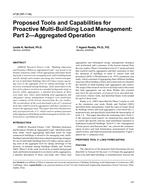Thermal environmental control is of major concern in the care of laboratory animals. The success of an experiment, as well as the physical well-being of the animals, is subject to environmental conditions.
This study evaluated the concept of radiant cooling for control of the sensible environmental conditions within the cage. Evaluation was performed using a heat transfer model that was developed to predict temperatures and heat transfer rates within the cage under various ambient environmental conditions, animal (dog) positions, and panel locations and temperatures.
A model was experimentally verified in an environmentally controlled test chamber by exposing the cage and simulated dog to 57 combinations of these variables. The operative temperature was used as an index for evaluation.
The panel created a microclimate within the cage that lowered the operative temperature by an average of 9.9 F (5.5°C) over an ambient dry-bulb range of 75 F (23.9°C) to 95 F (35°C).
Units: Dual
Citation: Symposium, ASHRAE Transactions, 1988, vol. 94, pt. 1, Dallas, TX
Product Details
- Published:
- 1988
- Number of Pages:
- 14
- File Size:
- 1 file , 1.9 MB
- Product Code(s):
- D-DA-88-24-4


